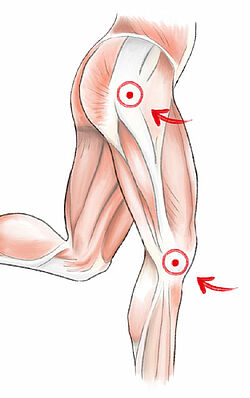Runner's Knee
Runner's knee is known under many names. The root cause is a tendinous plate on the outside of the thigh, which passes over the knee joint (iliotibial tract). That’s why iliotibial band syndrome (ITBS) is a medical synonym for runner's knee. Pain occurs due to pathological loading of this tendinous plate at the level of the knee joint space. This common injury is generally associated with running, especially in runners with high-volume training regimens. The problem is that the runners do not feel pain right at the beginning, but not until they are in their run. For many runners, symptoms do not occur until after they’ve been on the road for 6 to 7 km, after which the symptoms grow in strength and intensity to such a degree that the runner has to interrupt and postpone the overloading caused by the run. Malalignment of the knee often predisposes runners to suffer from runner's knee. Both bowleg (genu varum) and knock-knee (genu valgum) can contribute to the development of runner's knee. Action must be taken against both of these conditions. Malalignment caused by these deformities not only affects the associated muscle groups but the joints themselves. Initial therapeutic measures begin with the foot, because the position of the foot determines how the knee is aligned. In patients with genu varum, PROPRIO® foot orthoses are recommended to stabilize the outside of the leg by strengthening the peroneal muscles, which run along the (fibular) outside of the lower leg and evert the outer edge of the foot. A genu valgum deformity is exactly the opposite dysfunctional positioning of the knee joint. This condition requires that emphasis be put on strengthening the tibial muscle group, in particular the posterior tibial muscle. Logically, this muscle runs along the inner side of the shinbone behind the inner ankle and pulls the arch of the foot upwards. By influencing this structure with the aid of PROPRIO® foot orthoses, we can achieve alignment in the knee joint.

